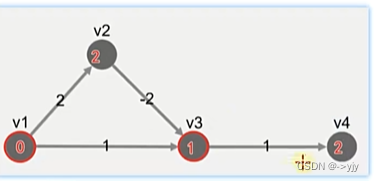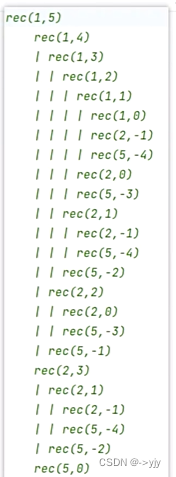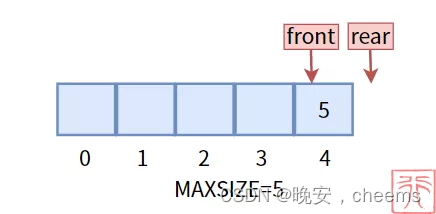1) 贪心例子
将寻找最优解的问题分为若干个步骤
每一步骤都采用贪心原则,选取当前最优解
因为没有考虑所有可能,局部最优的堆叠不一定让最终解最优
 v2已经不会更新v3因为v3更新过了
v2已经不会更新v3因为v3更新过了
算法>贪心算法是一种在每一步选择中都采取在当前状态下最好或最优(即最有利)的选择,从而希望导致结果是最好或最优的算法。这种算法通常用于求解优化问题,如最小生成树、背包问题等。
背包问题:给定一组物品和一个背包,每个物品有一定的重量和价值,要求在不超过背包容量的情况下,尽可能多地装入物品。
活动选择问题:在一个活动集合中,每次只能参加一个活动,问如何安排时间以最大化所有活动的收益。
编辑距离问题:给定两个字符串,求它们之间的最小编辑距离(即将一个字符串转换为另一个字符串所需的最少操作次数)。
网络流问题:给定一张有向图和一些起点和终点,求最大流量。
找零问题:给定一定数量的硬币和需要找零的金额,求使用最少的硬币数。
常见问题及解答:
算法>贪心算法一定会找到最优解吗? 答:不一定。算法>贪心算法只保证在每一步选择中都是最优的,但并不能保证整个问题的最优解。例如,背包问题中的算法>贪心算法可能会导致最后一个物品没有被装入背包。
如何判断一个问题是否适合用算法>贪心算法解决? 答:一个问题如果可以用递归的方式分解成若干个子问题,且每个子问题都有明确的最优解(即局部最优),那么这个问题就可以用算法>贪心算法解决。
算法>贪心算法的时间复杂度是多少? 答:算法>贪心算法的时间复杂度取决于问题的规模和具体实现。一般来说,对于规模较小的问题,算法>贪心算法的时间复杂度可以达到O(nlogn)或O(n^2);对于规模较大的问题,可能需要O(n^3)或更高。
几个贪心的例子
Dijkstra
// ...
while (!list.isEmpty()) {// 选取当前【距离最小】的顶点Vertex curr = chooseMinDistVertex(list);// 更新当前顶点邻居距离updateNeighboursDist(curr);// 移除当前顶点list.remove(curr);// 标记当前顶点已经处理过curr.visited = true;
}
没找到最短路径的例子:负边存在时,可能得不到正确解
问题出在贪心的原则会认为本次已经找到了该顶点的最短路径,下次不会再处理它(curr.visited = true)
与之对比,Bellman-Ford 并没有考虑局部距离最小的顶点,而是每次都处理所有边,所以不会出错,当然效率不如 Dijkstra
Prim
// ...
while (!list.isEmpty()) {// 选取当前【距离最小】的顶点Vertex curr = chooseMinDistVertex(list);// 更新当前顶点邻居距离updateNeighboursDist(curr);// 移除当前顶点list.remove(curr);// 标记当前顶点已经处理过curr.visited = true;
}Kruskal
// ...
while (list.size() < size - 1) {// 选取当前【距离最短】的边Edge poll = queue.poll();// 判断两个集合是否相交int i = set.find(poll.start);int j = set.find(poll.end);if (i != j) { // 未相交list.add(poll);set.union(i, j); // 相交}
}其它贪心的例子
选择排序、堆排序
拓扑排序
并查集合中的 union by size 和 union by height
哈夫曼编码
钱币找零,英文搜索关键字
change-making problem
find Minimum number of Coins
任务编排
求复杂问题的近似解
2) 零钱兑换问题
有几个解(零钱兑换 II)Leetcode 518
[1,2,5] 5 暴力递归
有解:[1, 1, 1, 1, 1]
无解:[1, 1, 1, 1, 2]
无解:[1, 1, 1, 1, 5]
有解:[1, 1, 1, 2]
无解:[1, 1, 1, 5]
无解:[1, 1, 2, 2]
无解:[1, 1, 2, 5]
无解:[1, 1, 5]
有解:[1, 2, 2]
无解:[1, 2, 5]
无解:[1, 5]
无解:[2, 2, 2]
无解:[2, 2, 5]
无解:[2, 5]
有解:[5]
4
public int rec(int index,int[] coins,int remainder){//1.情况1:剩余金额 < 0 - 无解//2.情况2:剩余金额 > 0 - 继续递归//3.情况3:剩余金额 = 0 - 有解if(remainder < 0){return 0;}else if(remainder == 0){return 1;}else{int count = 0;for(int i = index;i<coins.length;i++){count+=rec(i,coins,remainder-coins[i]);}return count;}}那这个递归是怎么运作的呢?
/* //第一次传入 index= 0=>1 处理硬币和剩余金额rec(1,5) remainder > 0 所以走else逻辑 再循环中的递归是多路递归rec(1,4)rec(1,3)rec(1,2)rec(1,1)rec(1,0) <== 1rec(2,-1) <== 0rec(5,-4) <== 0rec(2,0) <==1rec(5,-3) <== 0rec(2,1)rec(2,-1) <== 0rec(5,-4) <== 0rec(5,-2) <== 0rec(2,2)rec(2,0) <== 1rec(5,-3) <== 0rec(5,-1) <== 0rec(2,5-2=3)rec(2,1)rec(2,-1) <== 0rec(5,-4) <== 0rec(5,-2) <==0rec(5,5-5=0) < ==1*/

import java.util.ArrayList;
import java.util.LinkedList;
import java.util.ListIterator;/*** 零钱兑换* 可以凑成总金额所需的所有组合可能数*/
public class Leetcode518 {public int coinChange(int[] coins, int amount) {return rec(0, coins, amount, new LinkedList<>(), true);}/*** 求凑成剩余金额的解的个数** @param index 当前硬币索引* @param coins 硬币面值数组* @param remainder 剩余金额* @param stack -* @param first -* @return 解的个数*/public int rec(int index, int[] coins, int remainder, LinkedList<Integer> stack, boolean first) {if(!first) {//第一次不压栈stack.push(coins[index]);}// 情况1:剩余金额 < 0 - 无解int count = 0;if (remainder < 0) {print("无解:", stack);
// if(!stack.isEmpty()){
// stack.pop();
// }}// 情况2:剩余金额 == 0 - 有解else if (remainder == 0) {print("有解:", stack);
// if(!stack.isEmpty()){
// stack.pop();
// }count = 1;}// 情况3:剩余金额 > 0 - 继续递归else {for (int i = index; i < coins.length; i++) {count += rec(i, coins, remainder - coins[i], stack, false);}}if (!stack.isEmpty()) {stack.pop();}return count;}private static void print(String prompt, LinkedList<Integer> stack) {ArrayList<Integer> print = new ArrayList<>();ListIterator<Integer> iterator = stack.listIterator(stack.size());while (iterator.hasPrevious()) {print.add(iterator.previous());}System.out.println(prompt + print);}public static void main(String[] args) {Leetcode518 leetcode = new Leetcode518();
// int count = leetcode.coinChange(new int[]{1, 5, 10, 25}, 41);
// int count = leetcode.coinChange(new int[]{25, 10, 5, 1}, 41);
// int count = leetcode.coinChange(new int[]{5, 2, 1}, 5);int count = leetcode.coinChange(new int[]{1, 2, 5}, 5);
// int count = leetcode.change(new int[]{15, 10, 1}, 21);System.out.println(count);}
}但是这个代码放在leetcode上面跑会超时,因为重复处理了很多次相同的操作
我们可以考虑用记忆法 & 动态规划来优化
我们也可以考虑顺序优化 ==>规模下降明显
/* [5,2,1] 5 rec(5,5)rec(5,0) <== 1rec(2,3) rec(2,1)rec(2,-1) <==0rec(1,0) <==1rec(1,1)rec(1,0) <==1rec(1,4)rec(1,3)rec(1,2)rec(1,1)rec(1,0) <==1*/
但即使是这样写在leetcode上也是会 StackOverflowError
class Solution {public int change(int amount, int[] coins1) {int[] coins = sort(coins1);return rec(0,coins,amount);}int rec(int index,int[] coins,int remainder){int count = 0;if(remainder == 0){return 1;}else if(remainder<0){return 0;}else{for(int i = index;i<coins.length;i++){count+=rec(index,coins,remainder);}return count;}}/***传入一个有序的数组a(从小到大排序),返回一个从大到小的数组*@param a 传入的数组(有序)*@return 返回一个数组(从大到小)*/int[] sort(int[] a){int[] temp = a;if(temp.length % 2 ==0){//数组里面的个数为偶数for(int i = 0;i<=temp.length/2;i++){int temp1 = a[i];temp[i] = temp[temp.length-1-i];temp[temp.length-1] = temp1;}}else{//数组里面的个数为奇数for(int i = 0;i<temp.length/2;i++){int temp1 = a[i];temp[i]=temp[temp.length-1-i];temp[temp.length-1-i] = temp1;}}return temp;}
}import java.util.Arrays;public class Main {public static void main(String[] args) {int[] arr = sort(new int[]{1,2,3});System.out.println(Arrays.toString(arr));//为什么我这么选择是因为用Arrays.sort要将数组转化为Integer[]}/***传入一个有序的数组a(从小到大排序),返回一个从大到小的数组* @param a 传入的数组(有序)* @return 返回一个数组(从大到小)*/public static int[] sort(int[] a){int[] temp = a;if(temp.length%2==0){//数组里面的个数为偶数for (int i = 0; i <= temp.length/ 2; i++) {int temp1 = a[i];temp[i]=temp[temp.length-1-i];temp[temp.length - 1-i] = temp1;}}else{//数组里面的个数为奇数for (int i = 0; i < temp.length / 2; i++) {int temp1 = a[i];temp[i]=temp[temp.length-1-i];temp[temp.length - 1-i] = temp1;}}return temp;}
}动态规划->会在动态规划章节说明
最优解(零钱兑换)- 穷举法 Leetcode 322
import java.util.LinkedList;
import java.util.concurrent.atomic.AtomicInteger;public class Leetcode322 {static int min = -1; // 需要的最少硬币数 2 3public int coinChange(int[] coins, int amount) {rec(0, coins, amount, new AtomicInteger(-1), new LinkedList<>(), true);return min;}// count 代表某一组合 钱币的总数 可变的整数对象public void rec(int index, int[] coins, int remainder, AtomicInteger count, LinkedList<Integer> stack, boolean first) {if (!first) {stack.push(coins[index]);}count.incrementAndGet(); // count++if (remainder == 0) {System.out.println(stack);if (min == -1) {min = count.get();} else {min = Integer.min(min, count.get());}} else if (remainder > 0) {for (int i = index; i < coins.length; i++) {rec(i, coins, remainder - coins[i], count, stack, false);}}count.decrementAndGet(); // count--if (!stack.isEmpty()) {stack.pop();}}public static void main(String[] args) {Leetcode322 leetcode = new Leetcode322();
// int count = leetcode.coinChange(new int[]{5, 2, 1}, 5);int count = leetcode.coinChange(new int[]{25, 10, 5, 1}, 41);
// int count = leetcode.coinChange(new int[]{2}, 3);
// int count = leetcode.coinChange(new int[]{15, 10, 1}, 21);System.out.println(count);}
}最优解(零钱兑换)- 贪心法 Leetcode 322
自己看看就行因为有些测试样例过不了
假定传过来的数据就是从大到小排序,因为java对int数组从大到小排序比较麻烦
public class Leetcode322 {public int coinChange(int[] coins, int amount) {int remainder = amount;int count = 0;for (int coin : coins) {while (remainder - coin > 0) {remainder -= coin;count++;}if (remainder - coin == 0) {remainder = 0;count++;break;}}if (remainder > 0) {return -1;} else {return count;}}public static void main(String[] args) {Leetcode322 leetcode = new Leetcode322();int count = leetcode.coinChange(new int[]{5, 2, 1}, 5);
// int count = leetcode.coinChange(new int[]{25, 10, 5, 1}, 41);
// int count = leetcode.coinChange(new int[]{2}, 3);// 问题1 没有回头,导致找到更差的解
// int count = leetcode.coinChange(new int[]{15, 10, 1}, 21); // 问题2 没有回头,导致无解
// int count = leetcode.coinChange(new int[]{15, 10}, 20); System.out.println(count);}
}






